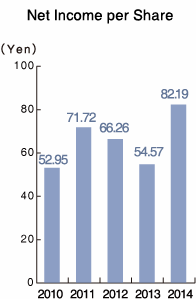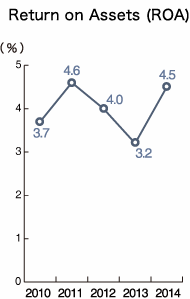Financial Review
USHIO INC. and Consolidated Subsidiaries
Year ended March 31, 2014
The USHIO Group?comprising the parent company and its 54 consolidated subsidiaries and 2 equity-method affiliates?engages mainly in manufacturing and marketing light sources, equipment, and machinery for industrial uses. The Group also engages in research and development and provides other services related to its businesses.
-
Economic Trends and USHIO’s Response
In the fiscal year ended March 31, 2014, growth was weak within some sectors in China, but the global economy expanded modestly overall, with evidence of recovery in Europe. The U.S. economy also continued to recover, despite facing challenges relating to monetary policy and fiscal matters. In Japan, improvement was gradual, as consumer spending, production, and other sectors picked up, spurred largely by the government’s policies, and demand in anticipation of the consumption (sales) tax increase from 5% to 8% in April 2014 gained momentum.
Under these economic conditions, the USHIO Group performed well overall in its target markets, partly as a result of the yen’s depreciation. In the imaging equipment-related market in particular, use of digital cinema projectors is now well established, contributing to strong replacement demand for xenon lamps for cinema projectors. In LCD panel- and semiconductor-related markets, capacity utilization rates were generally high, leading to firm growth in replacement demand for UV lamps. The Group’s photo-alignment system for high-definition smartphones and tablet PCs also witnessed expansion in demand, as did optical equipment for semiconductors and electronic devices.
The USHIO Group responded to these trends by developing new products in existing businesses (such as the solid-state light sources business) and actively investing in R&D targeting original, forward-looking technologies and products in new businesses such as the biomedical business. At the same time, it remained focused on making Group-wide efforts to improve its business performance by raising productivity, lowering manufacturing costs, reducing expenses, and promoting production in optimal locations.
-
Earnings
During the fiscal year ended March 31, 2014, sales and income increased in both the equipment business and the light sources business, partly due to the yen’s depreciation.
Net Sales
Consolidated net sales increased 10.0% year on year to \157,800 million. In the equipment business, imaging equipment for cinema-use recorded a drop in sales, but expanded sales of general imaging and non-cinema imaging equipment resulted in top-line growth overall. In optical equipment, sales were down slightly as a result of sluggish sales of exposure tools for electronic component manufacturing and business contraction in EUV lighting sources for photolithography, which outweighed the increased momentum in sales of the Group’s photo-alignment system for LCD panel manufacturing. In the light sources business, the discharge lamp sub-segment recorded robust performance in UV lamps used for photolithography, while xenon discharge lamps for cinema projectors and halogen lamps for office equipment and industrial applications also performed well.
Operating Income
Operating income increased 59.7% year on year to \12,110 million. In the equipment business, the main factors contributing to higher operating income included a rapid increase in demand for photo-alignment systems for LCD panel manufacturing from the second quarter, the benefits of the yen’s depreciation in the imaging equipment sub-segment, and the fact that the cost of developing EUV light sources had decreased. In the light sources business, strong sales were achieved primarily in xenon discharge lamps for cinema projectors and in halogen lamps for office equipment and industrial heater applications.
Net Income
Net income increased 50.5% year on year to \10,770 million. The improvement was attributable to higher ordinary income, and extraordinary gains of \1,900 million, primarily from sales of stock held, offset by extraordinary losses of \2,300 million, primarily for impairment of unlisted stock. An additional contributing factor was the absence of the extraordinary loss booked in the previous fiscal year as provision for adjustment losses accompanying the liquidation of XTREME technologies GmbH.
-
Results by Business Segment
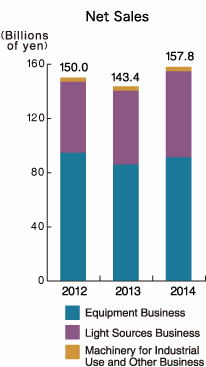
Equipment Business
The equipment business saw sales increase 6.2% year on year to \91,243 million, while segment profit jumped 119.1% year on year to \2,537 million. The yen’s depreciation contributed to a robust performance in the imaging equipment sub-segment of the business. Digital cinema projectors have achieved a high rate of penetration centered on the developed markets, and the focus of sales has now shifted to developing markets. Nonetheless, the USHIO Group launched compact models targeting such developing markets, and as a result, unit sales volume remained roughly on a par with the previous fiscal year. In general imaging equipment, sales held firm as the Group secured new orders for diverse applications. With its projectors used in an increasingly wide range of fields, sales expanded in the EMEA (Europe, the Middle East, and Africa) region particularly, and sales of control room projectors and other imaging equipment were brisk. In the optical equipment sub-segment, the protracted stagnation in demand for PCs continued, but capital expenditures in the semiconductor, electronic component, and LCD panel markets were on a recovery track, particularly among manufacturers of strong-selling smartphones and tablet PCs. As a consequence, sales of optical equipment, and photo-alignment systems in particular, grew steadily. During the year under review, the Group reduced R&D investment in the EUV light source business in step with its consolidation and continuation in Japan, while continuing to invest actively in R&D targeting new technologies and products that could lead to strong business results in the future.
Light Sources Business
Sales in the light sources business were up by 17.5% year on year to \64,192 million. Segment profit increased by 51.5% year on year to \9,389 million. The business performed well overall, partly as a result of the yen’s depreciation. Sales of xenon lamps for cinema projectors continued to expand, reflecting such factors as the increase in digital cinema screens and strong replacement demand in cinemas in developing markets in particular. Moreover, replacement demand for UV lamps for photolithography held firm as capacity utilization rates at LCD panel and semiconductor manufacturers remained high, tracking growth in demand for smartphones and tablet PCs. Sales of halogen lamps were also brisk, largely because inventory adjustment at the manufacturers that assemble office equipment had run its course. The USHIO Group continues to conduct product development in such areas as achieving longer replacement cycles, higher luminance, and greater efficiency for lamps, while actively conducting R&D focusing particularly on solid-state light source products (light-emitting diodes [LEDs] and laser diodes [LDs]).
Other Businesses
Sales in other businesses decreased by 7.6% year on year to \3,048 million and segment profit declined by 29.2% year on year to \77 million. Sales of mold protection devices and other equipment to manufacturers of strong-selling smartphones and tablet PCs expanded, but failed to surpass the previous fiscal year’s expansion in sales of molding machines, resulting in a weak performance.
-
Sources of Funds and Liquidity
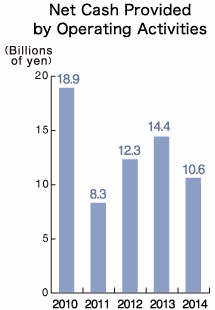
Cash Flows
Cash and cash equivalents on March 31, 2014 totaled \45,342 million, up \2,080 million from the previous fiscal year-end. Cash flows are broken down as follows.
Cash Flows from Operating Activities
Operating activities in the fiscal year ended March 31, 2014 provided net cash of \10,622 million (compared with net cash of \14,443 million provided in the previous year). Cash was mainly provided by \15,515 million in income before income taxes and minority interests and \5,021 million for depreciation and amortization. Meanwhile, factors reducing cash included a \3,287 million increase in notes and accounts receivable?trade, a \1,110 million increase in inventories, a \365 million decrease in notes and accounts payable?trade, and corporate income taxes paid of \3,761 million.
Cash Flows from Investing Activities
Investing activities used net cash of \4,476 million (compared with net cash of \8,649 million used in the previous year). Cash was mainly provided by proceeds from withdrawal of time deposits of \14,221 million, proceeds from sales and redemption of short-term investment securities of \2,660 million, and proceeds from sales and redemption of investment securities of \3,434 million. Cash was mainly used for an increase in time deposits of \13,006 million, purchase of short-term investment securities of \1,318 million, investment in property, plant and equipment of \5,041 million, purchase of investment securities of \3,181 million and \2,371 million for acquisition of a business.
Cash Flows from Financing Activities
Financing activities used net cash of \6,670 million (compared with net cash of \7,092 million used in the previous year). Cash was mainly provided by long-term loans payable of \3,075 million. Cash was mainly used by repayment of long-term loans payable of \5,080 million, purchase of treasury stock of \1,012 million, and payment of dividends of \2,884 million.
-
Financial Position
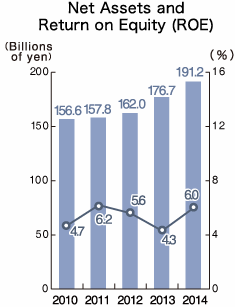
Current Assets
At the fiscal year-end, total current assets were \153,004 million, an increase of \12,358 million from the previous fiscal year-end. The main contributing factors were an increase in cash and deposits following foreign currency translation due to the yen’s depreciation and an increase in notes and accounts receivable?trade accompanying higher business volume.
Non-Current Assets
Total non-current assets amounted to \102,334 million, an increase of \14,322 million year on year. The main contributor was an increase in investment securities supported by a recovery in stock prices.
Current Liabilities and Long-Term Labilities
Total liabilities at the end of the fiscal year were \64,091 million, an increase of \12,218 million year on year. The main factor behind this increase was an increase in liability for retirement benefits (booked as a provision for retirement benefits in the previous fiscal year).
Net Assets
At the fiscal year-end, total net assets were \191,246 million, an increase of \14,462 million from the previous fiscal year-end. The main factors behind this rise were an increase in foreign currency translation adjustment due to the yen’s depreciation, and an increase in valuation difference on available-for-sale securities in line with higher unrealized gains on securities held.
-
Capital Expenditures
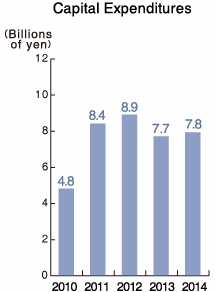
The USHIO Group’s capital expenditures for the fiscal year ended March 31, 2014 were \7,886 million. The bulk of this expenditure was for capital investment in the light sources and equipment businesses, with investments focused on building up existing facilities, as well as on businesses promising growth, and research and development. A breakdown of capital expenditures for the fiscal year follows. (Figures are calculated on an acceptance basis for property, plant and equipment, intangible fixed assets, and long-term prepaid expenses. Amounts do not include consumption tax or other levies.)
2014 Y-o-Y Change Light sources business \2,066
million65.8
%Equipment business \5,549
million124.6
%Other businesses \270
million149.5
%Total capital expenditures \7,886
million101.4
%Capital expenditures increased in fiscal 2014. This reflected the fact that in every segment the Group continued to make key investments aimed at strengthening the Group’s operational competitiveness in potential growth fields, while selecting investments rigorously and focusing on capital efficiency.
The USHIO Group’s investments focused mainly on the equipment and light sources businesses. In the equipment business, the Group focused its expenditure on optical equipment including exposure tools and photo-processing tools targeting diversifying market needs, as well as laser projectors and sound systems in visual imaging operations, and simulation systems and virtual reality in general imaging operations. In the light sources business, the Group focused primarily on expenditure to maintain its high quality and technological advantages and to expand its solid-state light sources (LEDs and laser diodes) business. The Group funded its capital expenditures with a combination of internally generated funds and borrowings.
Loss on disposal of fixed assets was \81 million, due to the disposal of plant facilities such as buildings and machinery in the light sources and equipment businesses.
-
Research and Development
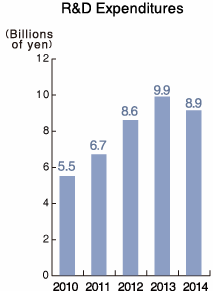
Group-wide R&D expenses totaled \8,924 million. Most of this was spent in the light sources and equipment businesses. The main target of the Group’s R&D is the development and manufacturing of light sources for industrial applications. In its businesses, the Group is aiming to combine optical components in integrated assemblies and to develop optical equipment and systems. That entails driving forward the development of a variety of ancillary technologies essential for making practical use of light, including optical technologies, electronics and mechatronics.
The Group keeps abreast of the latest developments in markets and technology and conducts strategic R&D activities. It is organized in a way that enables interaction among the R&D teams in its different product groups to encourage development of new kinds of light sources and equipment.
The USHIO Group’s key achievements during the fiscal year ended March 31, 2014 were as follows:
Light Sources Business
Developed downlight employing LEDs
Group subsidiary BLV Licht- und Vakuumtechnik GmbH developed the LEDTRION downlight, employing LEDs in a light source to create a downlight offering more than 2,000 lumens of light, high-level color rendering, and a compact shape.
Equipment Business
(1) Developed a blood analyzer employing immunochromatography
Developed the Point Reader® table-top blood analyzer, which employs immunochromatography, a method of measuring immunity based on capillary action. Launched Japan-based sales of the Point Reader® together with the accompanying Point Strip ® Ferritin series of serum ferritin reagents
(2) Developed direct imaging system for PCBs
Developed the UDI-8001P ultra-fine, high-speed direct imaging (DI) system for manufacturing next-generation FC-BGA packages for computers and network equipment
(3) Developed active stereo-compatible 3-chip DLP® 3D projector with 4K resolution at 120Hz performance
Group subsidiary Christie Digital Systems Canada Inc. developed the Christie Mirage 4K35 and 4K25 active stereo-compatible 3-chip DLP® 3D projectors. The world’s first 4K resolution projectors, these models can handle a 120Hz frame rate that projects 120 images per second.
(4) Developed LED follow spotlight
Group subsidiary Ushio Lighting, Inc. developed the Xebex® ULP-150, an LED follow spotlight for stage lighting purposes, which can illuminate specific individuals or points on a stage.
(5) Collaborated with Gifu University and ACTREE Corporation to develop the world’s first technology to decompose NOx at ambient temperature and without a catalyst
Together with Gifu University and ACTREE Corporation, the Group developed the world’s first “VUV direct denitration” technology. The technology uses VUV (vacuum ultraviolet radiation) to achieve denitration of NOx (nitrogen oxide), an atmospheric pollutant contained in exhaust gas, at ambient temperature without a catalyst.
(6) Developed the world’s first ultraviolet curing device using UV light to improve the bonding capacity of dental implants and reduce treatment time
The Group developed the TheraBeam® SuperOsseo, the world’s first ultraviolet curing device for dental implants, and started selling it in Europe. The device can give the artificial titanium tooth roots used for dental implant treatment more than three times the capacity to bond with bone by using ultraviolet curing to stimulate their surfaces. It can also reduce the time required for healing by approximately half.
(7) Achieved a parallel light conversion efficiency of 90% for LED light
The Group successfully developed optical technology to efficiently convert LED light into parallel light (LED collimation technology), achieving the industry’s highest parallel light conversion efficiency of 90%.
(8) Developed a vacuum ultraviolet (VUV) parallel light unit that enables direct, highly detailed patterning without the need for a photoresist
The Group developed the world’s first vacuum ultraviolet (VUV) parallel light unit that enables highly detailed patterning directly onto flexible substrates and other base materials without using a photoresist. Advances in the field of wearable computing and displays have led to growing interest in the potential of printed electronics, which use patterning on flexible substrates made of plastic or other materials to add features such as sensors and holograms directly.
-
Issues to Be Addressed
Looking ahead at the business environment for the USHIO Group, modest economic recovery and expansion is projected to continue. The markets for LCD panels, semiconductors, and other electronic components are expected to benefit from continuing strong sales of smartphones and tablet PCs accompanied by increased capital expenditures and high capacity utilization rates. Meanwhile, the imaging equipment-related market is witnessing declining sales of digital cinema projectors. This reflects a slowdown in the number of new digital cinema screens installed annually in developed markets, where use of digital projectors is now well established, although further growth in new installations of digital cinema screens is still anticipated in China and other emerging markets. The Group will address these developments in its business environment and markets, taking steps to expand its operations by making active strategic investments to develop new products, find new applications for its products, and launch new businesses.
The Group will enhance its product lineup to respond to diversifying market needs, reduce manufacturing costs throughout its operations, and improve quality and productivity. In addition, the Group will endeavor to expand and reinforce its manufacturing bases as well as its sales bases and networks both in Japan and overseas in order to expand its sales of light sources, optical equipment, and imaging equipment to global markets, and optimize its service structure, among other aims. The Group will seek to develop dynamic businesses by considering business partnerships, investments, or other options that could potentially supplement in-house development.
The USHIO Group regards environmental issues as a key management concern in terms of corporate social responsibility, and will continue to take active steps to save energy and resources, cut waste, increase recycling, and otherwise reduce its environmental footprint. Meanwhile, the Group will continue with measures to ensure that it merits the trust of all its stakeholders. These will involve optimizing its internal control systems by bolstering corporate governance and compliance, and ensuring continued stability in its operations by putting in place the best possible provision for risk management including business continuity planning.
-
Risks
Below is a summary of risks that could affect the USHIO Group’s business performance, financial position, and cash flow adversely and materially. These are the risks cited by management in the Group’s Yukashoken Hokokusho (Annual Securities Report) to the Japanese government, filed on June 26, 2014. This is only a partial listing, and the Group faces risks other than those cited here that could also affect its business performance, financial position, and cash flow materially.
(1)Market Fluctuations in Semiconductors and LCDs
The Group’s business performance is sensitive to demand fluctuations in the semiconductor and LCD industries. Currently, the USHIO Group’s principal products for those industries are replacement exposure lamps for manufacturing equipment, and demand for these lamps is generally steady while customer plants are operating. However, the semiconductor and LCD manufacturing equipment targeted by the Group is subject to changes in demand for products in the short-term and the medium-to-long-term, as well as to technological developments. Unexpected changes in demand or technological progress could affect the Group’s business performance and financial position materially.
(2)Market Fluctuations for Light Sources for Illumination and Irradiation
Outside of the semiconductor and LCD panel fields, the Group supplies light sources for installation in data projectors, illumination and radiation light sources for digital cinema projectors and other equipment, and visual imaging equipment and light sources. Trends in technology and fluctuations in prices and demand for these light sources could affect the Group’s business performance and financial position materially.
(3)Access to Raw Materials
The Group relies on externally sourced raw materials, which it obtains from a broad range of suppliers to ensure steady supplies of high-quality materials at stable prices. Rare metals such as tungsten and molybdenum are crucial raw materials for manufacturing lamps in particular. Supply shortages or price increases of those materials could increase the cost of manufacturing and affect the Group’s business performance and financial position materially.
(4)Developing Exposure Technology for Semiconductor Manufacturing
As semiconductor microcircuitry patterns become increasingly miniaturized, the number of semiconductor manufacturing systems using the Group’s discharge lamps remains high. However, semiconductor manufacturing is beginning to shift to other exposure technologies. The nature of future developments in exposure technology for manufacturing semiconductors could affect the Group’s business performance and financial position materially.
(5)Cross-Border Activities and Entry into Overseas Markets
The Group conducts manufacturing and sales activities in regions outside Japan, specifically other Asian nations, North America, and Europe. Entry into these overseas markets is associated with potential risks in each country that include changes in various rules and regulations, instability in securing human resources, underdeveloped infrastructure, and social unrest. If realized, these risks could affect the Group’s business performance and financial position materially.
(6)Intellectual Property
The Group operates in business sectors characterized by frequent technological advances. Protecting, maintaining, and managing patents, trademarks, and other intellectual property are influential factors in competitiveness and market share in those business sectors. Litigation could arise if a third party were to infringe on the Group’s intellectual property rights or if the Group were to infringe on a third party’s intellectual property rights. In addition, the patent authorities could refuse patent applications submitted by the Group. Any such event that would significantly comprise the Group’s protection of its intellectual property rights could affect the Group’s business performance and financial position materially.
(7) Currency Exchange Rates
The Group conducts its commercial and financial operations in yen and in other currencies. Profits and losses in the Group’s commercial and financial operations conducted in foreign currencies are therefore subject to the influence of fluctuations in currency exchange rates. The Group uses forward exchange contracts to moderate currency exchange risk, but it cannot negate that risk completely. Fluctuations in the foreign exchange markets could therefore affect the Group’s business performance and financial position materially.
(8)Fluctuations in Prices of Marketable Securities
The Group holds marketable securities as financial assets. Depending on stock market and other conditions, the fair value of these securities could decline. Therefore, the Group is exposed to the risk of fluctuations in the prices of marketable securities, which could affect the Group’s business performance and financial position materially.
-
Important Management Contracts
There are no important contracts to report.
